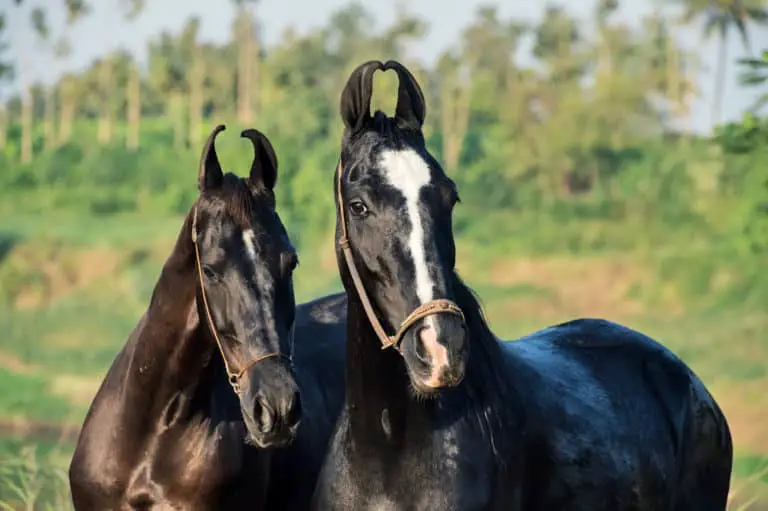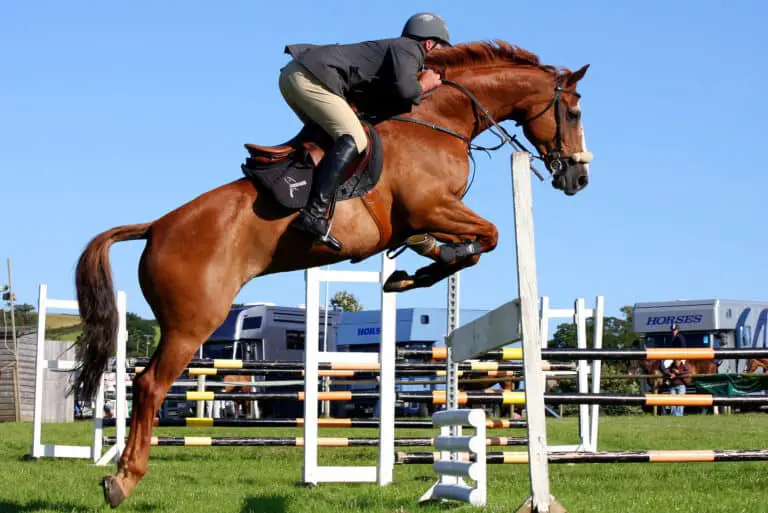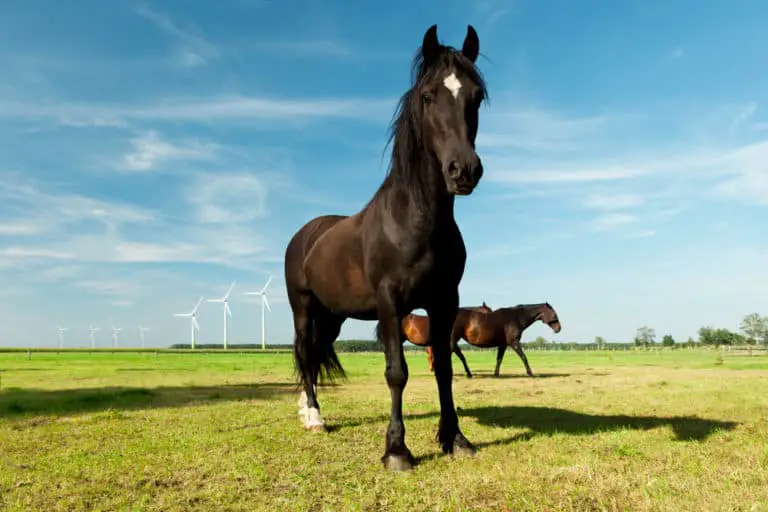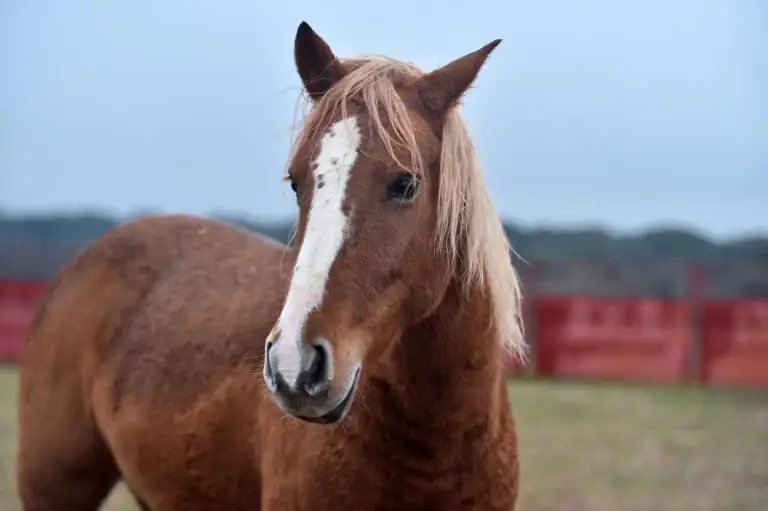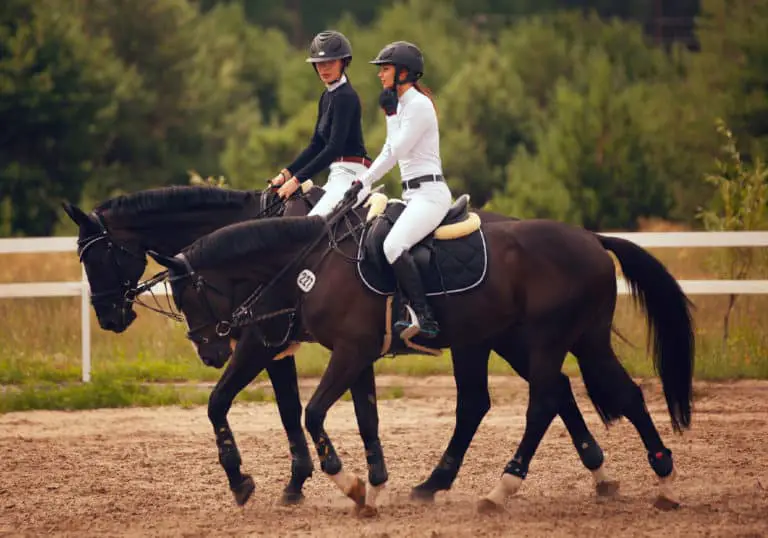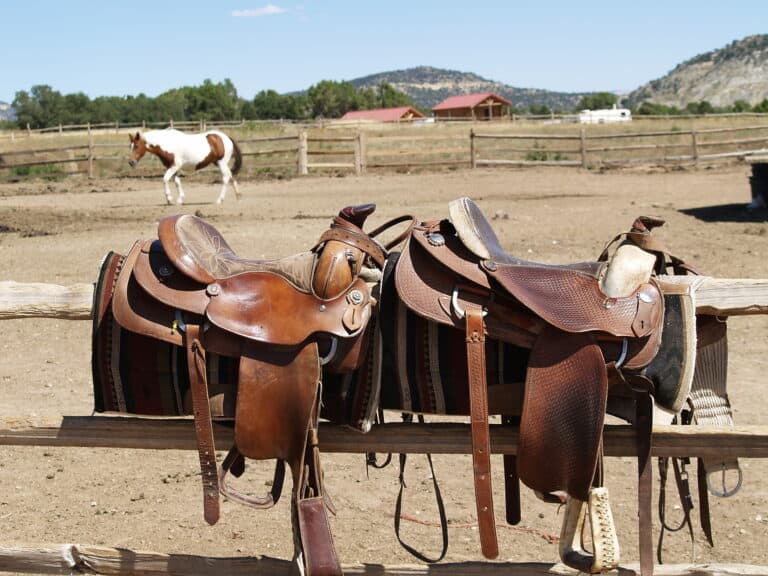Lusitano Horse Breed: Care, Cost & History (2025)

The Lusitano horse is a prestigious and majestic horse breed from Portugal. The sporty and elegant horses are known for their excellent achievements in equine disciplines and have an interesting history. The Lusitano is of a baroque type, meaning they are descendants with typical features of horses from the European Baroque era.
Breed: Lusitano horse
Adult Weight: 1102 lbs
Adult Height: 15.1 hands for females (61 inches) – 15.3h (63 inches) for males
Origin: Spain and Portugal
Use: Show, Dressage, Pleasure, Hunting
Colors: Bay, grey, chestnut
Features: Medium-sized, muscular, baroque-type
Lifespan: 25-30 years
Character: Gentle, Intelligent
Gait: Spirited, Agile, Sure-footed
Best for: All-level riders
- Characteristics
- Lusitano Horse Care
- Lusitano Horse History
- Modern Lusitanos
- Cost and Ownership
- Buying a Lusitano
- Similar Breeds
Lusitano Horse Characteristics
The Lusitano horse characteristics are typical to horses of the baroque type. The Lusitano breed is characterized by its muscular body built, its powerful hindquarters, and the Lusitano horse head shows a straight profile. The Portuguese Horse is often used for dressage due to its beautiful physical characteristics.
Size
The breeding standard classifies the Lusitano horse height as a medium. The breeding society rules, that a horse at the age of six years should have an average height at the withers of 15.1 hands for females (1,55m) and male Lusitanos should stand at 15.3h (1,60m) (1).
The Lusitano size is therefore average for light horse breeds. The intensive muscle weight of this breed makes up for the medium size and awards them with a bigger appearance at first sight. Of course, the height of every Lusitano might vary individually and depends on many factors like genes, crossbreeding, and sometimes even feed.
Weight
The Lusitano is considered a medium-sized horse by the official breeding standards. This is also true when it comes to Lusitano horse weight.
The Lusitano-Interagro, an official breeding society, refers to the Lusitano horse as a “middleweight” with a weight of around 500 kgs which is 1102 lbs (1). This is within the average weight of other light horse breeds.
A Lusitano is described as medium-lined with a sub-convex profile. They have rounded outlines due to their heavy muscles and the breeding standards say, that their silhouette can be fitted into a square. Lusitanos will appear of medium size with a muscular and heavy body that is well-defined.
Colors
The beautiful Lusitano horse has few limitations when it comes to coat colors and you can find these horses in almost any color. The breeding standards put no regulations on the accepted Lusitano horse colors, but they point out that the most appreciated and esteemed coat colors of the Lusitano breed are all shades of grey and bay (1).
Interestingly enough these colors are not rare Lusitano horse colors, like palomino or cremello, rather than the more common colors grey, bay, and chestnut.
Those are still the most appreciated within the breed since those colors are a witness to the rich history and tradition of this horse breed. This comes in handy when purchasing a Lusitano, since you won’t have to pay extra for rare or exotic coat colors, but more probably even less.
Temperament
The Pure Blood Lusitano is a very elegant horse when we look at Lusitano horse temperament. The breeding society describes Lusitano horse behavior as noble, generous, and ardent. Even if the Portuguese horse can be passionate and have a lot of temperament, they are supposedly always gentle with their riders and able to support duress (1).
Lusitanos are supposed to have a natural ability for concentration and a great disposition for training and work. They are said to have explicit courage and enthusiasm for the so-called “gineta exercises” which are combat, hunting, bullfighting, and the work with cattle.
Lusitano Horse Care
Caring for Lusitano horses is not different than caring for similar light horse breeds. To assure your precious steed a healthy and happy life which will also extend the Lusitano horse lifespan, there are a few things you need to take care of.
The most prominent care factors are the feed, board, and grooming of your Lusitano.
Diet and Nutrition
Portuguese horse breeds are not high-maintenance since they are natural grazers and do not need any particular food or supplement different from other light horse breeds.
But it has to be noted that the horses from the Iberian peninsula are used to low-protein intakes due to the dry forage they have evolved from (2).
The Lusitano diet should mainly consist of fibrous foliage like grasses, plants, herbs, and bark and forage for them to graze through. A salt block can be recommended for the horse to lick on to offer them more minerals.
If your horse has high-energy demands due to competitions like dressage, you should add some grain mixtures to their diet. If you think your horse might be at risk for EDM, you may want to supplement vitamin E.
Health Problems
The Lusitano horse breed is the most popular equine in Portugal and therefore breeding and health have been monitored and regulated quite well. If you care properly for your horse and assure a good feed, your horse will probably live a healthy and happy life.
Nevertheless, the Lusitano breed is not immune to health issues and genetic problems like most horse breeds.
The Portuguese horse has been found to inherit or develop the Equine degenerative myeloencephalopathy (EDM) which is a neurodegenerative disorder (3).
EDM has been associated with low vitamin E concentrations but has been found in the genetics of Lusitano horses as well.
Grooming
Lusitano grooming is luckily not very high-maintenance like that of feathered horses for example.
But since the beautiful Portuguese horses have heavy manes and tails as well, you will have a little more upkeep than with short-maned or lighter maned horses. Grooming can also help to ease social tension (4) and strengthen the relationship with your horse.
Grooming should be performed daily on your horse. Brush the coat and detangle the tail of your horse. The skin of Lusitanos can be sensitive and prone to skin irritation or sunburn.
Therefore, a well-maintained coat and skincare are essential for your horse’s health. If you live in very sunny areas, you should apply horse-friendly sunscreen on your horse’s lightly-haired areas like the muzzle, ears, and belly.
Lusitano Horse History
The Lusitano horse history is rich and old and mainly is located on the Iberia Peninsula, nowadays Portugal and Spain. As one of the oldest breeds in Europe, there is a lot to learn about the Portuguese horse.
The Lusitano had various different uses throughout history and was often referred to as caballo lusitano.
Origin
The first traces of the Lusitano horse origin were found even before the Neolithic period and were those of domesticated horses who died during this time period. Those horses are very likely the truest ancestors of the Lusitano horses.
Even the famous philosopher Homer, refers to the Iberian horses in the Iliad in Chapter XVI and claims they are fast as the wind and sons of Podargo (5).
Through several invasions, the horses have been crossbred with horses from North Africa and the Berbers, and later they were crossbred with German horses to redefine the breed characteristics.
Historic Development
A Lusitano stallion has had various different uses throughout history. They have been used for driving wagons and carrying people for more pragmatical purposes.
Later when they were crossbred with the horses of the invaders from North Africa, the breed became a strong and unchallenged warhorse in Europe. They were then often used to carry heavy soldiers in armor.
The strong Lusitano war horses were then exported to the Americas which is why nowadays there are some Lusitano breeding societies in Brazil. The Lusitano is said to be the descendent of many popular breeds in the US like Appaloosas and Quarter Horses (5).
When the postal services were invented the demand for Lusitanos declined over time and pure breeders became rare.
Notable Lusitano Horses
Since the Lusitano is a popular breed in Portugal and has been bred for many centuries, there are a lot of famous Lusitano horses that one might want to know about. Especially a prestigious
Lusitano horse pedigree has helped some Lusitanos to fame in disciplines like dressage and hunting.
Coroado
Coroado is a beautiful grey Lusitano gelding who wrote history for the Lusitano breed at the 2018 CDI-W Mechelen in the year 2018. The Portuguese duo of rider Maria Caetano and her grey Lusitano stallion Coroado became the first pair ever to achieve more than 80% in a Kur to Music.
Felix de Tineo
Felix de Tineo is also owned by the Portuguese rider Maria Caetano and is the brother of Coroado. The Lusitano stallion turned heads at the Grand Prix dressage at the Tokyo Olympics when he was making his debut at the Olympic dressage. He was only chosen because Coroado got injured shortly before, but he performed really well.
Talisco
Talisco was another grey Lusitano stallion who rose to fame due to his fine performances. He is already 22 years old and competed in dressage with excellent results. Talisco comes from the prestigious Lusit Studbook and sired many beautiful foals who then often became famous Lusitanos themselves.
Myths and Legends
The Portuguese have been quite vocal and poetic back in the day, which is why we do know about some Lusitano horse legends. Some legends and myths regarding this prestigious horse breed are surrounding either their appearance, their spirit, or especially their speed. Even Homer mentioned the horses from Iberia.
Horse from the Wind
The Portuguese horse of Iberia, which is nowadays called Lusitano, has supposedly been born from the wind. Or at least some ancient legends claim that Lusitano mares have been sired by the wind which is why they are very swift and fast horses. Supposedly these magical mares passed their special traits off to their foals then.
Centaur
Legend has it that the strong bond that existed between Iberian Horses and the Iberians was so strong and intimate that it inspired the idea of the famous mystical creature of the centaur. The centaur is half-human, half-horse, whereas the upper body is that of a human and the lower body parts are that of a horse.
Strong Genes
If you read about Lusitano horse history on the official breeder’s society site, you will notice that the Lusitano Horses were crossed with horses from other countries several times, but the Portuguese highlight that the Iberian features were not influenced in any way and that the horse remained pure.
Modern Lusitano Horses
Lusitano horses are a popular breed in Portugal, Brazil, and the US. Lusitano horses breeding
is similar to that of Andalusians. Lusitanos are the ancestors of many US breeds like the Quarter Horse or the Appaloosa.
Especially history enthusiasts like to choose a Lusitano over an American breed to have a more original horse. Lusitano breeding has become popular worldwide with the main breeding society residing in Portugal.
Breeding
Nowadays, Lusitanos are still mainly bred in Portugal and Brazil, but many other countries worldwide breed them as well. Those countries include the United States, Australia, Great Britain, and South Africa. The unique features make the breed a desired horse for many equestrians.
Until a few decades ago there was no separation between Lusitanos and Andalusians. But now the different types of Lusitano horses have been secluded from the Andalusian breed when the studbook was separated from the Spanish Horses in 1966.
In countries like Portugal and Brazil, it is very easy to find a Lusitano breeder, whereas in some states of the US they can still be scarce sometimes.
Population
Lusitano horse population is not generally low or endangered, but when it comes to the US population the Lusitanos are a super rare breed. Most Lusitanos are still located and bred in Portugal, Brazil, and Spain. There they are often used as horses for the Matadores who engage in bullfighting.
Only less than 60,000 Lusitanos are registered worldwide. This number is not as low as for other endangered breeds, but considering that approximately 16,000 Lusitanos live in the US (6), they can be rather difficult to find in some states.
Uses
Lusitano horse uses are very versatile and this breed is gifted when it comes to the Lusitano horse gait. The Lusitanos are popular choices for competing in dressage since they have a very agitated and smooth gait (1). They are elegant and disciplined and can perform really well in all equine disciplines.
There are several examples of Lusitano horses that participated in the Olympic Games and succeeded with their riders. Before modern times the Lusitano was used for driving and as a warhorse. Nowadays, especially in Spain and Portugal, they are held as pleasure horses by wealthy families.
Lusitano Horse Prices
As with almost any horse breed, the Lusitano horse price can vary considerably depending on where you live, if you have to import the horse and what achievements the horse has accumulated yet.
Age, Gender, and physical features can also determine the price of your Lusitano. Despite the purchase price, there are other regular expenses, like board, feed, and vet costs that you will need to consider.
Purchase Price
The price of a Lusitano horse will depend mainly on its traits. Those traits are age, sex, the Lusitano horse training, health, and the pedigree of the horse.
The price can be cheap if you buy a Lusitano foal in Portugal and you live there, or you can spend as much as $60,000 for prestigious and acclaimed stallions.
You definitely will have to spend less for a Lusitano in Spain or Portugal compared to the same value horse in the US. An average Lusitano horse in the US will cost you around $10,000-$15,000 (7).
Ownership Costs
When it comes to horsemanship costs, there are many different amounts to factor in. However, despite the initial purchase price of a Lusitano depending on your location, the costs for horse ownership are frequently similar for many light horse breeds.
The Lusitano horse cost of ownership can be compared to another light horse with a similar build. The costs comprise the initial Lusitano price, feed, board, and vet care.
Board
Boarding is almost the most significant factor in the price of owning a horse.
You will most probably have to pay monthly fees for stalling your Lusitano if you do not own a property or smallholding where your horse can live and graze for free.
The Lusitano horse board cost can range from 175$ per month for simple boarding to 750$ a month for show boarding and 650$ for full board (8).
Keeping a horse near a big city will be more expensive than in areas where there are a lot of equestrians already.
Feed
The Lusitano horse feed cost is not much different from that of other light horse breeds other than Lusitanos are used to low-protein intakes due to the dry forage they have evolved from the Iberian Peninsula (2).
The Lusitano diet should mainly consist of fibrous foliage like grasses, plants, herbs, and bark and forage for them to graze through (2).
This is because they are natural grazers like almost every other horse breed and mainly eat hay and grass. A bale of hay will cost around 2$ up to 14$ depending on the region you live in.
Veterinary Care
The Lusitano horse veterinary cost will approximately be 1,291$ a year if you have set up a yearly care plan (9). These costs cover annual vaccinations, the deworming for 12 months, and teeth floating once per year. However, anything unexpected like injuries, inflammations, or colics are not included and one of those health issues alone can cost $500-1,200$ depending on the severity of the problem.
Keep in mind that Lusitanos, especially if they are grey, can be prone to skin diseases.
Hoof Care
The Lusitano horse hoof care cost is another regular expense that you should be aware of. Lusitanos usually need to get new shoes or trims about every 6-8 weeks.
Full-shoeing a horses’ hooves will most likely cost around $1,300 a year (9). Front-Shoeing, your horse, will cost about 650$ a year. Just a trim of the hooves can cost up to 346$ a year as well.
Buying a Lusitano Horse
If you plan to buy a precious horse of the Lusitano breed, you need to search for a renowned breeder if registration and pedigrees are something that is important to you.
Keep in mind that anybody can claim to have a specimen of the Lusitano breed, but only a registered horse of the breeding society can be considered a true Lusitano.
Is the Lusitano Horse Right for You?
Lusitano horses are known to be very fast which is why riding a Lusitano horse feels like flying and gallop-loving riders will adore this breed.
Owning a Lusitano might be the right fit for equestrians who want to professionally compete in dressage or show since the gait and physical capabilities of this breed will be profitable in these disciplines.
Lusitanos have wonderful characters and are friendly horses who can perform really well in almost all equine sports. They are not the calmest breed known to humankind but could still be recommended to beginners since they are quick learners and kind.
How to Buy a Lusitano Horse?
First, look out for a Lusitano breeder of your choice. Maybe you know someone who already bought a horse from them and is happy with the breeder. Buying a Lusitano horse should be done with time and care.
Just like buying a dog or even marrying someone, you will spend many years with your horse and you have a lot of responsibilities. Make sure that the horse of your desire is a fit for your skills or for your goals.
Lusitanos are very intelligent and strong horses, so if you do not wish to train or compete with them regularly, maybe you would want to look for a calmer breed to satisfy both your and the horse’s needs better, Lusitanos have energy and so should you.
Similar Breeds to Lusitano
The best Lusitano breed alternatives are located in Spain and the US. The most obvious choice for a calmer, but very similar horse would be the Andalusian Horse.
If you are looking to spend less money, you might want to look for a more frequently sired horse like the American Quarter Horse that also has some genes of the Lusitano.
Andalusian
Some decades ago there was no difference between an Andalusian and a Lusitano Horse. Since 1966 only there has been a split between the Spanish and Portuguese studbooks into the Andalusian and Lusitano breeds.
Andalusians are also more frequently available when it comes to population. This is why the Andalusian would be a great alternative. They are also said to be calmer and more forgiving when it comes to temperament.
American Quarter Horse
Maybe not as exotic or foreign, but a trusted steed with many qualities and roots in Portugal is our beloved American Quarter Horse. American Quarter Horses are the most popular and therefore also an affordable breed worldwide.
They are disciplined and skilled horses and you do not have to import them or spend a fortune on a high-quality horse like it would be the case with a Lusitano.
Appaloosa
Looking for a challenge? The Appaloosa also has some roots in Portugal and Spain and it has more temperament than the Lusitano.
Appaloosas are horses for advanced riders and they are also more interesting looking than the uni-colored Lusitano. Another plus is, that they are easily available in the US and you don’t have to pay too much money to own one of those spotty horses.
FAQ
What is a Lusitano horse?
A Lusitano Horse is a horse breed from Europe that originates from Spain and Portugal. They are a popular choice for Dressage riders since they have a sure-footed and agile gait.
What does a Lusitano horse look like?
Lusitano horses are medium-sized and of the baroque type. They have a muscular and well-defined body.
How did the Lusitano horse get its name?
The Lusitano horse was named after the region on the Iberian Peninsula it originates from which was called Lusitania.
Can you ride a Lusitano horse?
Yes, a Lusitano horse can be ridden by all-level riders if they are trained and accustomed to be ridden.
Are Lusitano horses good for beginners?
There are more suitable horses for very insecure beginners, but strong-minded beginners will be able to handle this breed well since Lusitanos are kind and intelligent quick-learners.
How tall is a Lusitano horse?
The Lusitano horse stands between 15.1 – 15.3 hands at the withers.
How much does a Lusitano horse weigh?
Adult Lusitano Horses weigh approximately 1102 lbs (500kg).
How big is a Lusitano horse?
Lusitano Horses are medium-sized with a body that could fit into a square since they are muscular and compact but not small. They weigh approximately 1102 lbs and stand at 15.1-15.3 hands at the withers.
How much does a Lusitano horse cost?
An adult Lusitano can cost between $1,000 to $30,000.
How much does a Lusitano horse ownership cost?
You should at least expect to pay $1,291 a year for horsemanship. It can cost much more if you are paying for full board or your horse gets sick.
How long do Lusitano horses live?
Lusitano Horses live between 25 and 30 years if you care well for them.
How fast can a Lusitano horse run?
Lusitano Horses can at least run 30-35 mph. They are known to be very fast horses, but there is no exact documentation of what the fastest speed has been set.
How much can a Lusitano horse pull?
There is no specific amount known to how much a Lusitano can pull, but horses can usually safely pull 1/10 of their own body weight.
How much can a Lusitano horse carry?
A Lusitano Horse can safely carry a human rider up to 400 pounds.
At what age is a Lusitano horse full grown?
Lusitano horses are usually fully grown at the age of 4-5 years.
What are Lusitano horses used for?
Lusitano dressage is popular worldwide since the horses excel in this equine sport. Furthermore, they are used for pleasure and hunting.
References
- Interagro Lusitanos. 2022. Official Breed Standard. Link
- The Lusitano Society of Great Britain, Linda Bennis BSc. 2022. Feeding the Iberian. Link
- C. J. Finno, R. J. Higgins, M. Aleman, R. Ofri, S. R. Hollingsworth, D. L. Bannasch, Christopher Michael Reilly, J. E. Madigan, School of Veterinary Medicine. 2021. Equine Degenerative Myeloencephalopathy in Lusitano Horses. Link
- New Scientist. 1994. Science: Grooming Reaches the Parts. Link
- Interagro Lusitanos. 2022. The Origins and Evolution of the Lusitano. Link
- United States Equestrian Federation. 2022. Andalusian/Lusitano. Link
- Ehorses. 2022. Lusitano – horses for sale. Link
- New Horse. 2022. Horse Boarding. Link
- Equine Guelph. 2022. Annual Horse Expense Sheet. Link

